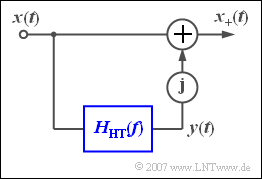Difference between revisions of "Aufgaben:Exercise 4.3Z: Hilbert Transformator"
From LNTwww
m (Text replacement - "Category:Exercises for Signal Representation" to "Category:Signal Representation: Exercises") |
|||
| Line 139: | Line 139: | ||
__NOEDITSECTION__ | __NOEDITSECTION__ | ||
| − | [[Category: | + | [[Category:Signal Representation: Exercises|^4.2 Analytical Signal and Its Spectral Function^]] |
Revision as of 13:39, 23 March 2021
The diagram describes a model of how, at least mentally
- from the real bandpass signal $x(t)$
- the analytical signal $x_{+}(t)$
can be generated.
The lower branch contains the so-called „Hilbert transformer” with the frequency response $H_{\rm HT}(f)$. Its output signal $y(t)$ is multiplied by the imaginary unit $\rm j$ and added to the signal $x(t)$ :
- $$x_{\rm +}(t)= x(t) + {\rm j}\cdot y(t) .$$
As test signals are used, each with $A = 1 \, \text{V}$ and $f_0 = 10 \, \text{kHz}$:
- $$x_1(t) = A \cdot {\cos} ( 2 \pi f_0 t ),$$
- $$x_2(t) = A \cdot {\sin} ( 2 \pi f_0 t ),$$
- $$x_3(t) = A \cdot {\cos} \big( 2 \pi f_0 (t - \tau) \big) \hspace{0.3cm}{\rm with}\hspace{0.3cm}\tau = 12.5 \hspace{0.1cm}{\rm µ s}.$$
Hints:
- This exercise belongs to the task Analytical Signal and Its Spectral Function.
- The following applies to the spectral function of the analytical signal:
- $$ X_{\rm +}(f)= \big[1 + {\rm sign}(f)\big] \cdot X(f).$$
Questions
Solution
(1) For the spectral function at the model output holds:
- $$X_{\rm +}(f)= \left(1 + {\rm j}\cdot H_{\rm HT}(f)\right) \cdot X(f).$$
- A comparison with the given relation
- $$X_{\rm +}(f)= \left(1 + {\rm sign}(f)\right) \cdot X(f)$$
- shows that $H_{\rm HT}(f) = - {\rm j} \cdot \sign(f)$ ist.
- Thus, the real part we are looking for is ${\rm Re}[X_{\rm +}(f)]\hspace{0.15cm}\underline{=0}$ and the imaginary part is equal to ${\rm Im}[X_{\rm +}(f)]\hspace{0.15cm}\underline{=-1}$.
(2) From the spectral function
- $$X_1(f) = {A}/{2}\cdot\delta (f + f_{0})+ {A}/{2}\cdot\delta (f - f_{0}).$$
- becomes according to the Hilbert transformer:
- $$Y_1(f) = {\rm j}\cdot {A}/{2}\cdot\delta (f + f_{0})-{\rm j}\cdot {A}/{2}\cdot\delta (f - f_{0}).$$
- Thus the signal at the output of the Hilbert transformer is:
- $$y_1(t) = A \cdot {\sin} ( 2 \pi f_0 t ) \hspace{0.3cm}\Rightarrow \hspace{0.3cm}y_1(t=0)\hspace{0.15 cm}\underline{ =0}.$$
(3) Now the spectral functions at the input and output of the Hilbert transformer are:
- $$X_2(f) = {\rm j}\cdot {A}/{2}\cdot\delta (f + f_{0})-{\rm j}\cdot {A}/{2}\cdot\delta (f - f_{0}),$$
- $$Y_2(f) = -{A}/{2}\cdot\delta (f + f_{0})- {A}/{2}\cdot\delta (f - f_{0}).$$
- It follows that $y_2(t) = - A \cdot \cos(2\pi f_0 t)$ und $y_2(t = 0)\; \underline{= -\hspace{-0.08cm}1 \,\text{V}}$.
(4) This input signal can also be represented as follows:
- $$x_3(t) = A \cdot {\cos} ( 2 \pi f_0 t - 2 \pi \cdot {\rm 10 \hspace{0.05cm} kHz}\cdot {\rm 0.0125 \hspace{0.05cm} ms}) = A \cdot {\cos} ( 2 \pi f_0 t - \pi/4)\hspace{0.3cm} \Rightarrow \hspace{0.3cm}y_3(t) = A \cdot {\cos} ( 2 \pi f_0 t - 3\pi/4).$$
- The signal phase is thus $\varphi = \pi /4$.
- The Hilbert transformer delays this by $\varphi_{\rm HT} \; \underline{= 90^\circ} \; (\pi /2)$ verzögert.
- Therefore, the output signal $y_3(t) = A \cdot \cos(2\pi f_0 t -3 \pi /4)$ and the signal value at time $t = 0$ is $A \cdot \cos(135^\circ) \; \underline{= -0.707 \,\text{V}}$.
(5) The spectral function of the signal $x_3(t)$ is:
- $$X_3(f) = {A_0}/{2} \cdot {\rm e}^{{\rm j} \varphi}\cdot\delta (f + f_{\rm 0}) + {A_0}/{2} \cdot {\rm e}^{-{\rm j} \varphi}\cdot\delta (f - f_{\rm 0}) .$$
- For the analytical signal, the first component disappears and the component at $+f_0$ is doubled:
- $$X_{3+}(f) = {A_0} \cdot {\rm e}^{-{\rm j} \varphi}\cdot\delta (f - f_{\rm 0}) .$$
- By applying the Verschiebungssatzes , the associated time function with $\varphi = \pi /4$ is thus::
- $$x_{3+}(t) = A_0 \cdot {\rm e}^{{\rm j}( 2 \pi f_{\rm 0} t \hspace{0.05cm}-\hspace{0.05cm} \varphi)}.$$
- Specifically, for time $t = 0$:
- $$x_{3+}(t = 0) = A_0 \cdot {\rm e}^{-{\rm j} \hspace{0.05cm} \varphi} = A_0 \cdot{\cos} ( 45^\circ)-{\rm j}\cdot A_0 \cdot{\sin} ( 45^\circ)= \hspace{0.15 cm}\underline{{\rm 0.707 \hspace{0.05cm} V}-{\rm j}\cdot {\rm 0.707 \hspace{0.05cm} V}}.$$
Hint:
- To get from $x(t)$ to $x_+(t)$ , just replace the cosine function with the complex exponential function.
- For example, the following applies to a harmonic oscillation:
- $$x(t) = A \cdot {\cos} ( 2 \pi f_0 t -\hspace{0.05cm} \varphi) \hspace{0.3cm} \Rightarrow \hspace{0.3cm} x_{+}(t) = A \cdot {\rm e}^{{\rm j}( 2 \pi f_{\rm 0} t \hspace{0.05cm}-\hspace{0.05cm} \varphi)}.$$
